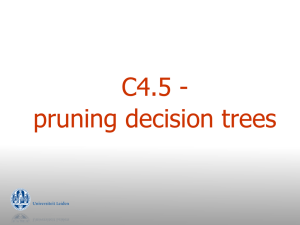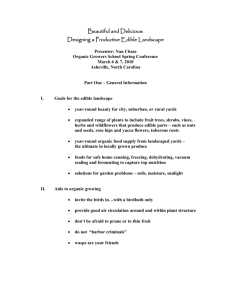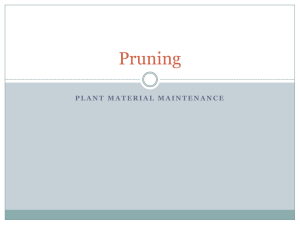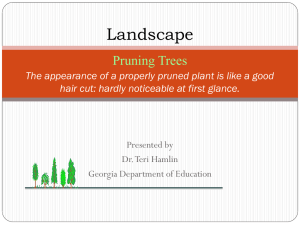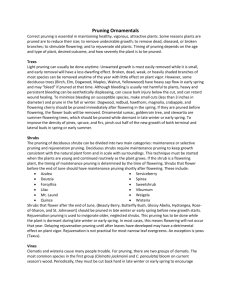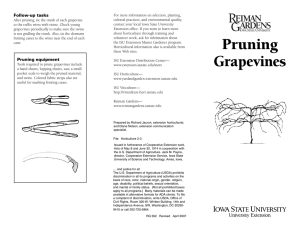Pruning Guide - Philadelphia Orchard Project
advertisement
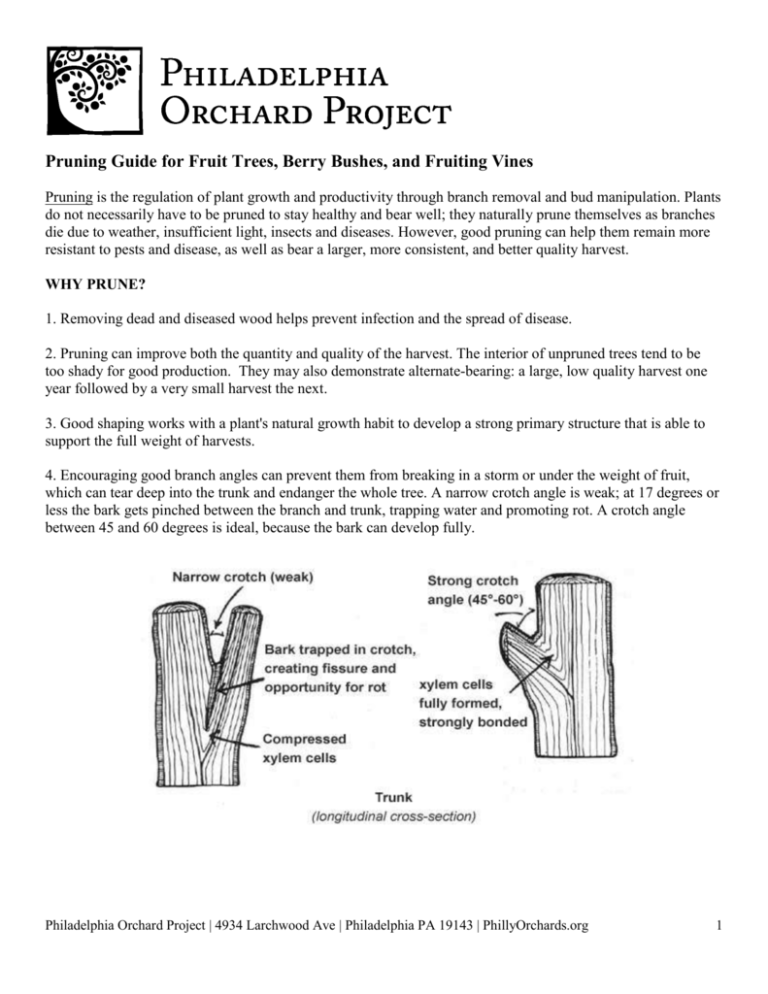
Pruning Guide for Fruit Trees, Berry Bushes, and Fruiting Vines Pruning is the regulation of plant growth and productivity through branch removal and bud manipulation. Plants do not necessarily have to be pruned to stay healthy and bear well; they naturally prune themselves as branches die due to weather, insufficient light, insects and diseases. However, good pruning can help them remain more resistant to pests and disease, as well as bear a larger, more consistent, and better quality harvest. WHY PRUNE? 1. Removing dead and diseased wood helps prevent infection and the spread of disease. 2. Pruning can improve both the quantity and quality of the harvest. The interior of unpruned trees tend to be too shady for good production. They may also demonstrate alternate-bearing: a large, low quality harvest one year followed by a very small harvest the next. 3. Good shaping works with a plant's natural growth habit to develop a strong primary structure that is able to support the full weight of harvests. 4. Encouraging good branch angles can prevent them from breaking in a storm or under the weight of fruit, which can tear deep into the trunk and endanger the whole tree. A narrow crotch angle is weak; at 17 degrees or less the bark gets pinched between the branch and trunk, trapping water and promoting rot. A crotch angle between 45 and 60 degrees is ideal, because the bark can develop fully. Philadelphia Orchard Project | 4934 Larchwood Ave | Philadelphia PA 19143 | PhillyOrchards.org 1 5. Shorter trees and lower fruit growth make for easier harvesting. An unpruned tree may grow upward without bearing until the fruit is out of reach or tree is too large for the space. 6. Pruning maximizes fruit production and health by controlling vegetative growth. Shoots, water sprouts, and vertical branches drain a tree's energy. Suckers grow from below the graft union and divert energy from the grafted tree. 7. Sunlight to the interior of the tree is essential for flower bud formation and fruit ripening. 8. Increased air circulation to the interior prevents development of fungal diseases and reduces pest populations. KNOW YOUR PLANT How, when, and what to prune will depend on what type of tree you are working with. Be familiar with your tree's growth habit (pyramidal, spreading, bushy, climbing, vigorous) so as to choose the pruning style best suited to the plant's natural growth tendencies. Also learn about its fruiting habit; inadvertently pruning fruiting wood or specialized fruiting structures can seriously compromise a tree's ability to bear fruit. WHEN TO PRUNE: Damaged and diseased wood, suckers and watersprouts should be promptly pruned, no matter what time of year. Annual pruning should be done during the dormant season, before buds begin to swell, and preferably on a day when the temperature is above freezing (late January through early March). Most tree diseases are dormant in winter, thus reducing the spread of infection. Pruning cuts will also heal most quickly during the spring growing season to follow. Some exceptions include... Peaches should be pruned after they bloom. Apples, pears, grapes can be pruned earlier, starting in late December. Espaliered fruit trees need both dormant and active season pruning to maintain their form. Philadelphia Orchard Project | 4934 Larchwood Ave | Philadelphia PA 19143 | PhillyOrchards.org 2 PRUNING METHODS Thinning: To allow more light and air into the interior, cut small side branches back to their point of origin on the parent branch – a highly recommended technique. Tipping: To induce horizontal branching, remove the terminal bud to a lateral bud heading in the direction you want branch to grow. Make the cut ¼” above lateral bud (to allow for dieback) and at an angle parallel to the direction of the bud. Notching: By nicking vascular tissue above or below a lateral bud, you can determine whether a bud becomes a shoot or a flower. The nick should be close to the bud, about 1/8” wide, but not deep (a mere scratch - to cut the phloem just below the bark surface). It should reach halfway around the stem. To produce a shoot, notch above dormant bud, cutting off the flow of growth hormones from terminal bud. To produce a flower, notch below the dormant bud, sending the flow of carbohydrates from the leaf to the bud instead of the rest of the tree. OTHER SHAPING METHODS Spreading, bending: hanging weights (molded concrete hangers, water jugs, etc,), using clothespins in late May-June, tying branches to ground or mouse guards, or using various length sticks with deheaded nails in each end to widen branch angles, making branches more fruitful & fruit more reachable without cutting. Always bend partially to side, not down, to prevent breaking. Damaging Cuts – Do Not Use! Heading: Cutting the branch to a stub, lateral branch, or side branch removes the terminal bud, resulting in a dense outer shell of weakly attached shoots. The tree's natural habit will be lost to bushy growth. Shearing: One of the worst things you can do to a fruit tree is to remove a set length from all of the outer growth, in which cuts fall randomly above and below buds. Removal of the terminal buds causes flush of dense, bushy growth, which is fine for hedges, but can ruin trees. Philadelphia Orchard Project | 4934 Larchwood Ave | Philadelphia PA 19143 | PhillyOrchards.org 3 BASIC STRUCTURE OF FRUIT TREES Central Leader The central leader method is for trees with a strong vertical (conical, pyramidal) growth habit (apples, pears, European plums). Usually 3 tiers (whorls), each consisting of 4 branches, 6-9” apart, and spaced evenly around the trunk. Tier #1: 2-3' above ground Tier #2: 5-6' above ground Tier #3: 8-9' above ground Modified Central Leader The modified central leader is an alternate method for trees with a strong vertical growth habit, recommended for cherries, pears, and some apples. 5-6 branches are left spiraling evenly up the trunk, 8-12" apart, but the trunk is cut back to a main branch at 5-8', and treated like vase. Open-center from that point. Vase or Open-Center Vase or open-center is used for tees with a spreading, vase-shaped growth habit (such as peaches, and plums). A whorl of 3-5 branches is left within 2-3' above ground; any main trunk is cut back to the topmost branch. BASIC STEPS IN PRUNING Note: never remove more than 30% of living wood in one growing season or there will be a flush of vegetative growth as the tree tries to restore its former food-producing capacity. 1. After removing dead and diseased wood, start with bending. Then, use thinning cuts primarily, and tipping only to encourage lateral branching. 2. Don't prune off fruiting spurs on apples, pears, apricots, and plums. On peaches and sour cherries, thin the fruit-bearing wood by removing twigs under 4-6”. 3. Keep the central area open by removing crossed, crowded, and inward growing branches. This increases light to interior and improves air circulation. 4. Prune for branch strength by removing branches with acute crotches (less than 17 degrees between the branch and the main trunk). Encourage wider angles by training narrow forks through spreading techniques. Philadelphia Orchard Project | 4934 Larchwood Ave | Philadelphia PA 19143 | PhillyOrchards.org 4 Making the Cut: To removing a branch less than 1” wide you will make a single cut just outside the outermost ring of the branch collar. Start by locating the branch collar, which is a swollen area of compressed rings of bark tissue/wood at the base of a branch. It is the point at which the growth pattern of the trunk overlaps that of the branch, strengthening the connection of the branch to the tree as new growth is added each year. Branch collar tissue is the tissue that heals and closes over the wound made by removing a branch. It is also a storehouse of phenolic compounds which prevent fungal diseases from entering the plant while the wound is healing. Make precise cuts. Never cut into the branch collar. The proper cut may leave an unsightly wedge of wood, but cutting into the branch collar reduces the tree's capacity to heal. Don't leave a stub. If more than 1/8" of wood is left outside the branch collar, the wound takes much longer to heal, because the healing tissue of the branch collar must grow out over that extra wood. This increases the risk of attack by insects and diseases. Always make a flat cut. Do not try to sculpt the cut to the contours of the branch collar as you may accidentally damage the branch collar tissue. A three cut approach is best for pruning branches larger than 1” in thickness. Although the final cut should be made in the same location, just outside the branch collar, preparatory cuts are recommended to avoid the weight of the branch tearing down the side of the trunk and causing significant damage to the tree. Use a handsaw rather than a pruner to make cuts on larger branches. The first cut should be made on the underside of the branch, a couple inches out from the branch collar. Saw only a quarter to halfway through the branch. This prevents the weight of the branch from tearing towards the trunk on the second cut. The second cut should be made just beyond the first cut. Saw all the way through the branch from the top. This removes most of the weight of the branch. Make the third and final cut just outside of the branch collar, perpendicular to the branch bark ridge. Philadelphia Orchard Project | 4934 Larchwood Ave | Philadelphia PA 19143 | PhillyOrchards.org 5 Pruning Notes for Specific Fruit and Nut Trees: Apple (Malus)- Preferred form depends on variety, but modified central leader works for most. Spreading/bending branches is recommended. Thin fruit to 5” apart. Apricot (Prunus armeniaca)- Open center or modified central leader. Thin fruit to 2” apart if necessary. Cherry, Sweet (Prunus avium)- Modified central leader. Head leader to create sidebranching. Cherry, Tart (Prunus cerasus)- Open center or modified central leader. Fig (Ficus)- In protected sites, can be grown as open center form. In spring, remove winterkilled branches. In exposed sites, wrapping or mulching may be needed for winter protection. Hazel/Filbert (Corylus)- Open center, with moderate pruning to stimulate growth. Jujube (Zizyphus)- Minimal pruning needed. Juneberry (Amelanchier)- Minimal pruning needed. Medlar (Mespilus)- Minimal pruning needed. Mulberry (Morus)- Minimal pruning needed. May be severely cut back to maintain smaller size. Pawpaw (Asimina)- Minimal pruning needed. Peach (Prunus persica)- Prune during or just after flowering. Remove up to 50% each year. Open center form. Prune upright sprouts during growing season. Thin fruit to 8” apart. Pear (Pyrus)- Central leader or modified central leader. Spreading/bending branches is recommended. Thin fruit to 5” apart. Persimmon (Diospyros)- Modified central leader. Shorten long willowy shoots. Plum (Prunus)- Open center form, except for European varieties that prefer central leader. Thin to 2” apart on heavy bearing varieties. Philadelphia Orchard Project | 4934 Larchwood Ave | Philadelphia PA 19143 | PhillyOrchards.org 6 Pruning Notes for Berry Bushes: BRAMBLES (cane-bearing shrubs): Blackberries (Rubus)- In summer, pinch out tips of new canes when they reach 3’ height. In winter, remove all 2nd year canes and thin out to 8 or 10 strongest new canes. Shorten canes to 7’ and laterals to 15”. Raspberries (Rubus)- Remove all canes after 2nd year. Thin out weak or crowded 1st year canes. For “everbearing” varieties, shorten remaining canes to below previous fruiting. MULTI-STEMMED SHRUBS: Use thinning cuts for a less bushy effect. This increases light and air circulation to the interior of plant. Remove stems that are more than 4 to 6 years old; older stems are less productive, so their removal enables younger stems to take their place. When pruning, cut stems to l-2” above crown of plant. Note: never remove more than 30% of living wood in one growing season or there will be a flush of vegetative growth as the plant tries to restore its former food-producing capacity. Blueberry (Vaccinium)- Cut back stems older than 4 years. Currant/Gooseberry (Ribes)- Remove shoots after their 3rd year. Remove all but 6 new stems. Elderberry (Sambucus)- Cut out wood older than 3 years and thin new suckers. Goumi (Eleagnus)- Minimal pruning needed. Philadelphia Orchard Project | 4934 Larchwood Ave | Philadelphia PA 19143 | PhillyOrchards.org 7 Pruning Notes for Vines: Grapes: During the First year after planting, simply cut to 2-3 buds. During the second year you must select a training system. If you have 2 wires, use the 4-arm kniffin method, if one wire, use singlecurtain cordon method, if you have a fence, use the fan system to utilize the area of the fence. Decide on a height for the trunk and thin the plant to a single trunk. Cut back to just over the height of the highest canes you want. If no vine reaches the desired height, repeat simple first year pruning to focus energy from the weak roots into 2-3 good shoots, one of which will be chosen next year as the trunk. During the third year select 4 vines of first year wood. Always choose thick, vigorous vines with at least 6” between nodes (places where this year's buds will grow). Cut them to 10 buds on each, then select 4 other vines and cut them to 2 buds each. Each subsequent year select the 4 best vines (usually from the 2-bud stubs you left last year) and cut to 10 buds (for Concord grapes 15 buds is okay) for this year's bearing wood. Remove last year's bearing vines, but leave four 2-bud stubs to produce next year's bearing wood To prune an overgrown vine select the canes to save, choosing from the canes which received the most sun during the previous season. They are usually darker in color and larger in diameter (at least as thick as a pencil). Cut Concord grape vines to the best 60 buds, cut less vigorous varieties to 40 buds (these are the maximum numbers for a mature, healthy plant, which lead to good quality grapes). Hardy Kiwis (Actinidia): Regardless of the structure they are growing on, kiwi vines should be pruned initially to a single trunk and trained straight up by tying to a post (no twining!). At the appropriate height for the structure, the vine should then be pruned into two permanent cordons (main branches) in opposite directions. Thin out laterals growing from the cordon to 12” apart. Additional summer pruning is needed to keep these vigorous vines under control. Philadelphia Orchard Project | 4934 Larchwood Ave | Philadelphia PA 19143 | PhillyOrchards.org 8

